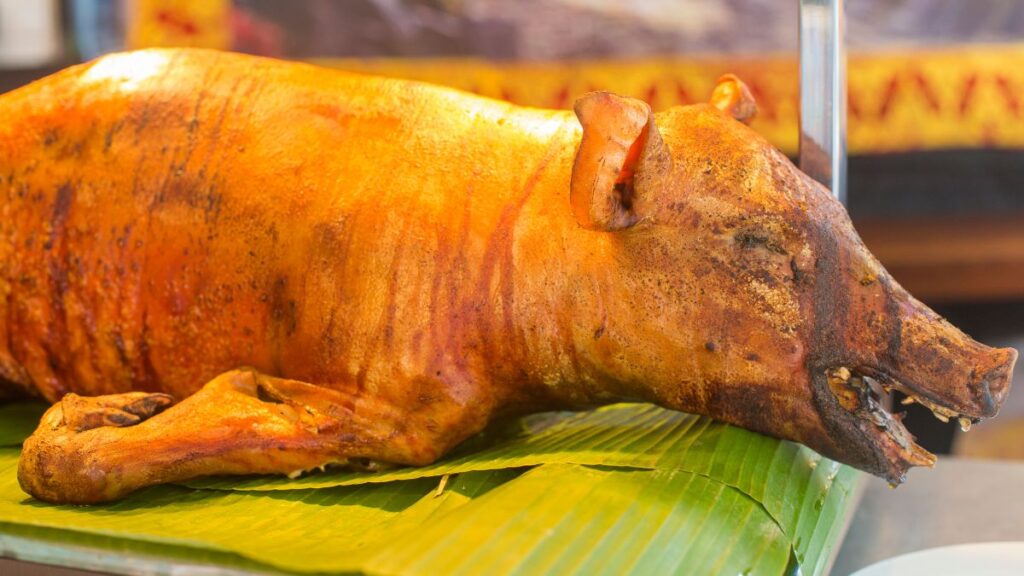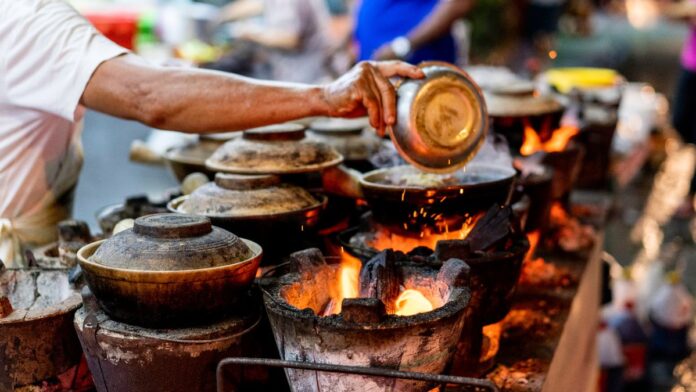Most of us travel for fun or food, there’s very little else outside of those two things. We wanted to combine the two and bring you a fun Southeast Asian food guide. If you are a passionate traveller and dedicated food lover, Southeast Asia presents an endless banquet of flavours, often hidden in places only the locals know.
This Southeast Asian food guide reveals some of the best-kept culinary secrets across Thailand, Malaysia, Vietnam, and Indonesia — destinations where each meal tells a story, and every bite is steeped in heritage. These aren’t the flashy restaurants with foreign appeal; rather, they’re the tucked-away gems where authenticity and taste matter the most.
READ MORE: Here are 4 emerging travel destinations in Southeast Asia
Penang, Malaysia: Peranakan Cuisine and Penang’s Street Food Culture

Penang is a treasure trove of multicultural flavours, bringing together Malay, Chinese, Indian, and Peranakan influences. The Peranakan culture, originating from Chinese immigrants who settled in Malaysia and Indonesia, has birthed an entire culinary genre that melds Chinese ingredients with Malay spices, resulting in flavourful and aromatic dishes. That’s why we put it first in our Southeast Asian food guide.
Where to Go: One hidden gem is China House, a heritage building in George Town that is part café, part art gallery, and part bakery, serving up classic Peranakan dishes. For a local experience, venture to Air Itam Market for a bowl of the famous Assam Laksa, a tangy, spicy fish soup known for its punchy tamarind-based broth, garnished with cucumber, mint, and pineapple.
What to Try: Assam Laksa is a must, but don’t miss Char Kway Teow, stir-fried flat noodles with prawns, cockles, eggs, and chives. Street vendors use charcoal to cook this dish, which imparts a subtle smoky flavour unique to Penang.
Tip: Head to George Town’s hawker centres in the evening when the food is freshly cooked. Dishes cost as little as RM6 (around USD 1.30), offering unbeatable value. Arrive early to avoid queues, and bring cash as most vendors are cash-only.
Chiang Mai, Thailand: The aromas of Northern Thai cuisine

Northern Thailand’s cuisine has a depth of flavour that distinguishes it from more familiar Thai dishes. It’s spicier, more aromatic, and typically less sweet. Chiang Mai, the region’s culinary capital, brims with food markets and small eateries where one can taste the rich diversity of Lanna cuisine (the ancient kingdom that once ruled northern Thailand).
Where to Go: For an immersive local experience, try Huen Phen, a traditional restaurant that serves Chiang Mai classics like Khao Soi and Sai Oua (Northern Thai sausage). Another must-visit is Chang Phuak Gate Night Market, where stalls are run by locals offering delicacies unique to the north.
What to Try: Khao Soi, a curry noodle soup with a creamy coconut base, is perhaps Chiang Mai’s most beloved dish. Topped with crunchy fried noodles, pickled mustard greens, and a dash of lime, it’s both comforting and complex. The Northern Thai sausage, Sai Oua, combines ground pork with herbs like lemongrass, kaffir lime, and galangal for a robust flavour.
Tip: At Chang Phuak Gate, expect meals under THB 50 (USD 1.50). Vendors open in the late afternoon, and the market becomes especially lively around 6 PM. Don’t hesitate to ask locals for recommendations—they’re usually delighted to guide visitors toward their favourite dishes.
Hanoi, Vietnam: A tour of authentic street food

Hanoi, Vietnam’s capital, is synonymous with street food culture. Here, street vendors line every alley and boulevard, serving dishes that are deeply rooted in Vietnamese tradition. Food in Hanoi tends to be fragrant and light, emphasizing fresh herbs and clear broths. Dining here is an experience for all the senses: the scent of charcoal smoke, the sound of sizzling pans, and the vibrant colours of ingredients.
Where to Go: The Old Quarter is the city’s beating heart and home to an abundance of street vendors. For an insider favourite, try Bun Cha Huong Lien, known for its bun cha, a dish beloved by locals long before it was catapulted to fame by former U.S. President Barack Obama’s visit.
What to Try: Bun Cha is a combination of grilled pork served with vermicelli noodles, fresh herbs, and a dipping sauce that’s both sweet and tangy. Pho Ga, or chicken noodle soup, is another classic that can be found on nearly every street corner, offering a rich, yet delicately spiced broth.
Tip: Aim to dine like the locals by pulling up a small plastic stool and enjoying your meal by the roadside. Dishes here are very affordable, often under VND 50,000 (USD 2). If you’re unsure where to start, follow the crowds—they often lead to the best spots.
READ MORE: We ranked the top places to be a digital nomad in Southeast Asia
4. Bali, Indonesia: Balinese Babi Guling and the island’s unique offerings

Beyond its beaches, Bali holds a special place in the culinary hearts of food explorers. The island has a unique spin on Indonesian cuisine, with Balinese dishes rich in spices and a little sweeter than other Indonesian fare. Bali’s food often incorporates ceremonial flavours, inspired by its Hindu traditions.
Where to Go: For a taste of traditional babi guling (roast pig), visit Warung Ibu Oka in Ubud, a local favourite that serves juicy, tender pork with Balinese spices. For a lighter experience, head to Sanur Night Market, a bustling evening spot popular with locals.
What to Try: Babi Guling is typically seasoned with turmeric, coriander seeds, and lemongrass before being slow-roasted. Another must-try is Nasi Campur, a mixed rice dish served with vegetables, fried tofu, peanuts, and meats like chicken satay. Each bite introduces you to a different layer of Balinese flavour.
Tip: Sanur Night Market offers dishes for as little as IDR 20,000 (USD 1.30). Visiting early in the evening ensures you’ll find the freshest food, especially for popular items like babi guling which can sell out by nightfall.
5. Phnom Penh, Cambodia: The savoury-sweet balance of Khmer cuisine

Relatively known, Cambodian food often flies under the radar. However, Phnom Penh’s dining scene reveals its many charms and unique wonders. Khmer cuisine balances sweet and savoury flavours, using ingredients like coconut milk, lemongrass, and fish sauce. Dining in Cambodia means exploring complex dishes that are influenced by neighbouring Thailand and Vietnam yet uniquely Cambodian.
Where to Go: Try Romdeng, a restaurant in a French colonial villa that’s also a social enterprise helping disadvantaged youth. Here, you can enjoy authentic Khmer dishes in a relaxed setting. For a more casual experience, visit the Phsar Kandal Market, where street vendors cook up local favourites in open-air stalls.
What to Try: Cambodia’s national dish, Amok Trey (fish amok), is a mild, coconut-milk-based curry wrapped in banana leaves. Also, try Bai Sach Chrouk, a breakfast dish made of marinated pork with rice, often served with pickled vegetables and a touch of sweet chilli.
Tip: Dishes in local markets usually cost around USD 1 to USD 2. To get the best out of your market experience, visit early in the morning when vendors are setting up. This is also the ideal time to sample Bai Sach Chrouk, as it’s traditionally enjoyed for breakfast.
Is this your Southeast Asian food guide?
Each meal across Southeast Asia is an experience for the senses and promises an immersion into the region’s culture. From the fiery spices of Chiang Mai to the rich coconut curries of Bali, each bite is vibrant, fresh and unique. For those willing to wander off the beaten path, Southeast Asia offers an unparalleled culinary adventure that can be enjoyed without breaking the bank. Embrace these hidden gems, and you’ll uncover more than just great food—you’ll experience the soul of Southeast Asia.

